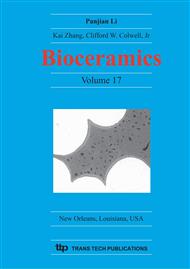p.1019
p.1023
p.1027
p.1033
p.1037
p.1041
p.1045
p.1049
p.1053
Comparing Dynamic Hip Screw to External Fixation for Treatment of Osteoporotic Pertrochanteric Fractures: A Prospective Randomized Study
Abstract:
External fixation has proven to be a viable minimally invasive treatment option for elderly patients with trochanteric fractures. Postoperative complications has limited external fixation in relation to inadequate pin fixation. We compared Orthofix pertrochanteric fixator (OPF) with hydroxyapatite-coated pins to dynamic hip screw (DHS) with AO/ASIF stainless-steel screws in osteoporotic trochanteric fractures. Methods: Forty patients were divided into two groups and randomized for treatment with 135° 4-hole DHS (Group A) or OPF with four hydroxyapatite-coated pins (Group B). Inclusion criteria was: female, age ≥ 65 years, AO fracture type A1 or A2 and BMD lower than -2.5 T-score. All fixators were removed at 3 months. Results: There were no differences in patient age, fracture type, BMD, ASA, hospital stay and reduction quality. Average number of blood transfusions was 2.0 ± 0.1 in Group A, whereas there were none in Group B (p < 0.0001). Operative time was 64 ± 6 minutes in Group A and 34 ± 5 in Group B (p < 0.005). Post-operative femoral neck shaft angle was 134 ± 6° in Group A, and 132 ± 4° in Group B (ns). In Group A, fracture varization at 6 months was 6 ± 8°, in Group B 2 ± 1° (p = 0.002). Harris hip score was 62 ± 20 in Group A and 63 ± 17 in Group B. (n.s.) In Group B, no pin infection occurred. Pin fixation was maintained over time, as shown by no significant difference between pin extraction and corresponding insertion torque. Discussion and Conclusion: In external fixation with hydroxyapatite-coated pins there was no need for blood transfusions and fixation was superior, as confirmed by less varization at long-term.
Info:
Periodical:
Pages:
1037-1040
Citation:
Online since:
April 2005
Authors:
Price:
Сopyright:
© 2005 Trans Tech Publications Ltd. All Rights Reserved
Share:
Citation:


